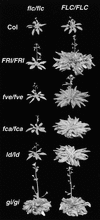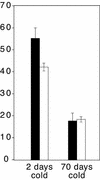Loss of FLOWERING LOCUS C activity eliminates the late-flowering phenotype of FRIGIDA and autonomous pathway mutations but not responsiveness to vernalization
- PMID: 11283346
- PMCID: PMC135534
- DOI: 10.1105/tpc.13.4.935
Loss of FLOWERING LOCUS C activity eliminates the late-flowering phenotype of FRIGIDA and autonomous pathway mutations but not responsiveness to vernalization
Abstract
The MADS domain--containing transcription factor FLOWERING LOCUS C (FLC) acts as an inhibitor of flowering and is a convergence point for several pathways that regulate flowering time in Arabidopsis. In naturally occurring late-flowering ecotypes, the FRIGIDA (FRI) gene acts to increase FLC levels, whereas the autonomous floral promotion pathway and vernalization act to reduce FLC expression. Previous work has shown that the Landsberg erecta allele of FLC, which is not a null allele, is able to partially suppress the late-flowering phenotype of FRIGIDA and mutations in the autonomous pathway. In this study, using a null allele of FLC, we show that the late-flowering phenotype of FRIGIDA and autonomous pathway mutants are eliminated in the absence of FLC activity. In addition, we have found that the downregulation of SUPPRESSOR OF OVEREXPRESSION OF CONSTANS1 by FRI and autonomous pathway mutants also is mediated by FLC. Complete loss of FLC function, however, does not eliminate the effect of vernalization. Thus, FRI and the autonomous pathway may act solely to regulate FLC expression, whereas vernalization is able to promote flowering via FLC-dependent and FLC-independent mechanisms.
Figures






References
-
- Borner, R., Kampmann, G., Chandler, J., Gleissner, R., Wisman, E., Apel, K., and Melzer, S. (2000). A MADS domain gene involved in the transition to flowering in Arabidopsis. Plant J. 24, 591–599. - PubMed
-
- Burn, J.E., Smyth, D.R., Peacock, W.J., and Dennis, E.S. (1993). Genes conferring late flowering in Arabidopsis thaliana. Genetica 90, 147–155.
-
- Chouard, P. (1960). Vernalization and its relations to dormancy. Annu. Rev. Plant Physiol. 11, 191–238.
-
- Clarke, J.H., and Dean, C. (1994). Mapping FRI, a locus controlling flowering time and vernalization response in Arabidopsis thaliana. Mol. Gen. Genet. 242, 81–89. - PubMed
-
- Johanson, U., West, J., Lister, C., Michaels, S., Amasino, R., and Dean, C. (2000). Molecular analysis of FRIGIDA, a major determinant of natural variation in Arabidopsis flowering time. Science 290, 344–347. - PubMed
Publication types
MeSH terms
Substances
LinkOut - more resources
Full Text Sources
Other Literature Sources
Molecular Biology Databases
Research Materials

